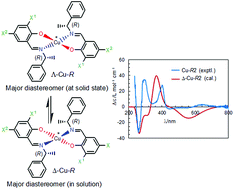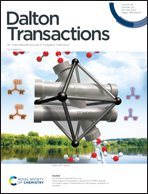Solid-state to solution helicity inversion of pseudotetrahedral chiral copper(ii) complexes with 2,4-dihalo-salicylaldiminate ligands†
Abstract
The enantiopure Schiff bases (R or S)-N-1-(phenyl)ethyl-2,4-X1,X2-salicylaldimine (X1, X2 = Cl, Br, I) coordinate to copper(II) and provide pseudotetrahedral bis[(S or R)-N-1-(phenyl)ethyl-(2,4-X1,X2-salicylaldiminato-κ2N,O)]-Δ/Λ-Cu(II) (Λ/Δ-Cu-R or Δ/Λ-Cu-S). An induced Λ and Δ-chirality at-metal centre has been launched along the C2-axis of the molecule. Steric constraints brought by halogen substituents on the coordinating salicylal ring provide diastereoselectively Λ-Cu-R or Δ-Cu-S as major and Δ-Cu-R or Λ-Cu-S as minor diastereomers at solid-state, as evidenced by X-ray crystal structures and PXRD analyses. These results reveal inversion of induced chirality at-metal in comparison to the similar complexes without halogen substituents on the salicylal ring. Electronic circular dichroism (ECD) spectra show mirror-image relationships, confirming enantiomeric excess of the R or S-ligated complexes in solution. Comparisons of experimental and simulated ECD spectra suggest diastereomeric excess of Δ-Cu-R or Λ-Cu-S in solution which correspond to an inversion from the found solid-state Λ-Cu-R or Δ-Cu-S as major diastereomers. In addition, the optimized gas-phase structures also reveal Δ-Cu-R or Λ-Cu-S as slightly more stable than Λ-Cu-R or Δ-Cu-S. Thus, solid-state versus solution (or gas-phase) studies also indicate an interconversion of induced chirality (helicity inversion) at-metal from Λ-Cu-R or Δ-Cu-S to Δ-Cu-R or Λ-Cu-S. Thermal stability increases with the molecular weight of the complexes following Cl < ClBr < Br < I substituents. Hirshfeld surface analyses explore the strongest halogen (ortho)–halogen (para) interactions between two molecules in Λ-Cu-R3 or Δ-Cu-S3 at a distance shorter than the sum of the van der Waals radii of the two iodine atoms, provide a brilliant red spot on the dnorm surfaces. EPR spectra along with simulation suggest an axial symmetry with gz > gx,y > 2.0 and values for gz/Az ≥ 135 cm indicate pseudotetrahedral geometry for the complexes.

- This article is part of the themed collection: Celebrating our Golden Authors


 Please wait while we load your content...
Please wait while we load your content...